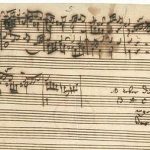A Life Come Full Circle

Richard Strauss
Richard Strauss (1864-1949) was a musical prodigy with his earliest compositions penned at the age of 6. His career spans the period of Brahms’ greatest celebrity—Strauss helped to prepare the orchestra for the premiere of Brahms’ Symphony No. 3—to the post-WW II era, a span of almost unimaginable cultural and artistic transformation. A contemporary of Gustav Mahler, Strauss’s music is similarly informed with a richly post-Romantic intensity and scale. Since the time of Strauss’s earlier attempted collaboration with Elgar, Strauss had conducted some performances of Elgar’s oratorio, The Dream of Gerontius, in 1901-2, to their meeting in 1920, Strauss had risen to a place of wide renown as the greatest living German opera composer producing Salome (1905), Elektra (1908), and Der Rosenkavalier (1910). Yet another World War would intervene between that hopeful meeting and the creation of Strauss’ final opus, the eloquently personal Four Last Songs, composed a year before the composer’s death at the age of 85. The devastation and turmoil of the Second World War undoubtedly took a toll on Strauss whose musical style and language had such strong ties to a now distant but glorious past. By the time he composed these last songs, many of the theaters where his operas were premiered were destroyed by Allied bombs, his family suffered under the Nazi persecution of Jews (his daughter-in-law, Alice, was Jewish and survived the war as a consequence of Strauss’ stature and influence), and the character of European concert music was already transformed by Schoenberg and the new Viennese School, Bartók and other Eastern European folk-based composers, and Stravinskyian Neo-classicism. But throughout the first half of the century, Strauss remained largely unaffected by these modernist trends. His music remained consistently lush, intensely melodic, and persistently autobiographical.

Pauline Strauss de Ahna
Strauss composed songs throughout his career and his operatic roles are relished by singers, especially the principal soprano. Strauss’ preference for writing for sopranos is undoubtedly tied to his love for and 55-year marriage to his wife, Pauline, a singer whom Strauss met when she was a voice student in Munich. In his final years Strauss had composed a number of works that seem to be in some ways a kind of reflection, through the eyes of age and long experience, on both the past and an awareness of what lay ahead. A work that closely preceded the Last Songs, the Metamorphosen for 23 solo strings, is a work of deep and transcendent beauty, what Michael Kennedy described as an “effusion of the deepest spiritual desolation.” Strauss was clearly reflecting on life and death. The four songs that make up the cycle are all in some way connected to this reflection, not in a mournful or morose sense, but in one of wonder, appreciation, and even ecstasy. These last songs are a valedictory of the most sublime musical character.
For the texts of these songs Strauss chose to set three poems by a contemporary poet, Herman Hesse, and one by the early 19th-century poet, Joseph von Eichendorff. The Eichendorff poem, “Im Abendrot” was the first to be composed, but was placed last in the set by Strauss’ publisher after the composer’s death. The first song, “Frühling” (Spring) seems to rise from darkness, as a rocking theme in the strings introduces the voice singing of the appearance of spring, a veneration of the divine character of nature itself. In “September” the music is both wistful and enchanted. The soprano sings of a decaying garden, pausing to recall the life and beauty that once was there before “closing weary eyes.” The song closes with a heartrending solo in the French horn as the music gradually recedes. “Beim Schlafengehen” (Going to sleep) uses the metaphor of sleep to signify the release of death, moving, as the first two verses describe, from the struggles of life, to the soaring joy of the soul’s final journey in the third. A magnificent violin solo serves as an angelic transition between the mortal opening verses to the ecstatic final one.
In what surely is a final tribute to both his wife and their life’s journey together, the final song “Im Abendrot” (At sunset) describes an old couple contemplating the end of their days. They are at peace with the world and life, and anticipate a kind of spiritual transfiguration. Strauss changed one word in the final line of Eichendorff’s poem from, “is that perhaps death?” to “is this perhaps death,” making the question even more poignantly personal than the original. In the closing orchestral epilogue, Strauss briefly quotes the transfiguration theme from one of his youthful tone poems. On his deathbed, he uttered his last words to his daughter-in-law, Alice: “Death is just as I composed it in Death and Transfiguration.
Don’t miss our shimmering presentation of
Classics IV: Strauss and Schumann, featuring Sarah Coburn.
Tickets can be purchased here.








